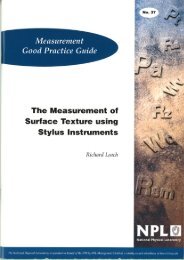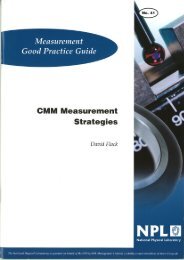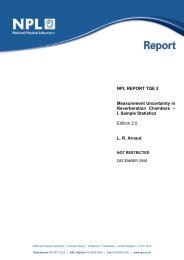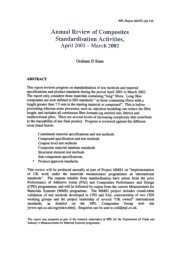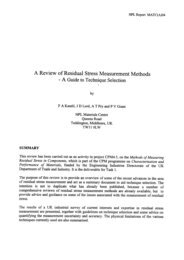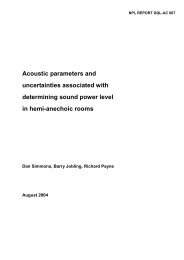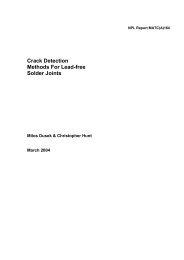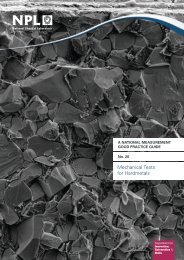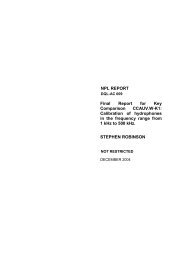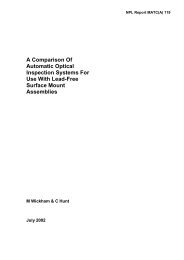Dimensional Measurement using Vision Systems - NPL Publications ...
Dimensional Measurement using Vision Systems - NPL Publications ...
Dimensional Measurement using Vision Systems - NPL Publications ...
You also want an ePaper? Increase the reach of your titles
YUMPU automatically turns print PDFs into web optimized ePapers that Google loves.
<strong>Measurement</strong> Good Practice Guide No. 39<br />
• The standard deviation each of the measurements must be taken into account. Since<br />
each spot is measured 3 times we divide it by the square root of 3, giving the<br />
standard uncertainty of the mean (or standard deviation of the mean). Where N<br />
measurements are made, the standard deviation is divided by √N.<br />
So the combined standard uncertainty for each of the measurements, by summing in<br />
quadrature, is ±√ 0.079+ (SD/√3) 2 , where SD is the standard deviation of the<br />
measurements. This gives us a standard uncertainty of ±0.28 µm for the measurements<br />
and the expanded uncertainty is ±0.56 µm, for a 95% confidence level.<br />
By comparing results, it can be seen that the measurement uncertainty when <strong>using</strong> the<br />
system as a comparator is seven times smaller than when <strong>using</strong> it in a direct measurement<br />
mode. For highest accuracy measurements vision systems should therefore be used as<br />
comparators whenever possible. However, it is also worth noting that the accuracy of the<br />
results from the direct measurement mode example is well within the measurement<br />
uncertainty. It is, of course, up to the end user to decide what level of accuracy and<br />
uncertainty is acceptable for his particular measurements. Further information regarding<br />
the calculation of uncertainty may be found in the <strong>NPL</strong> <strong>Measurement</strong> Best Practice Guide<br />
No. 11, ‘A Beginner’s Guide to Uncertainty of <strong>Measurement</strong>.’<br />
8 WORDS OF WARNING<br />
Making accurate measurements is as much about being confident of the measuring<br />
system’s 1 performance history as it is about its day-to-day repeatability. Whilst modern<br />
vision systems generally exhibit excellent measurement repeatability and reproducibility,<br />
measurement errors can still be produced. This can be due for example to the use of<br />
incorrect or inappropriate measurement practices, technical problems with the equipment,<br />
calibration errors, changes in environmental conditions or operator errors. In order to<br />
minimize such problems and ensure that accurate measurements are made, users are<br />
recommended to take steps to regularly monitor the performance of their measuring<br />
systems by acquiring and analysing statistics on repeatability and reproducibility. This will<br />
enable departures from ‘the normal’ to be spotted at an early stage and allow action to be<br />
taken to identify and correct the source of the errors in order to return the measuring system<br />
to its desired operating state.<br />
1 The measuring system here includes the vision system, any associated equipment or<br />
accessories required for the measurement and the operator.<br />
57



